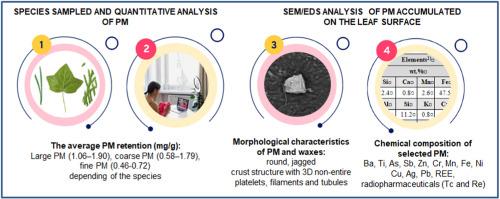Role of broad- and needle- leaf morphology in capturing particulate matter and emerging pollutants in urban environments
IF 7.3
2区 环境科学与生态学
Q1 ENVIRONMENTAL SCIENCES
引用次数: 0
Abstract
Urban air pollution remains one of the key environmental and public health issues, with particulate matter (PM) acting as a major carrier of harmful contaminants. This study explored the occurrence of emerging and established contaminants, including radiopharmaceuticals, heavy metals, and rare earth elements within PM deposited on the broad- and needle- leaf surfaces of urban trees. Broad- and needle- leaf samples of Hedera helix L., Pinus sylvestris and Thuja occidentalis were collected from an urban-industrial area in Gliwice, Poland. The morphology of the leaf surfaces and the composition of PM deposited on the leaves were examined using scanning electron microscopy coupled with energy dispersive x-ray spectroscopy (SEM/EDS). A quantitative analysis of particle fractions (large, coarse, fine) was performed through sequential filtration and gravimetric weighing following the washing of the plant material. The results indicated that the PM capture capacity of broad- and needle- leaf species depends on the morphological traits intrinsic to the species. The plant species with the greatest potential for retention of particulate matter was P. sylvestris, where deposited particles constituted 0.33% of the total mass of the P. sylvestris needle- leaves. Particulate matter can be characterised by compounds containing potentially toxic elements: heavy metals such as As, Sb, Cr, Ni, Cu, Zn, Pb, Cd, and Hg; other elements such as Ba, Ti, Fe, Mn, and Ag; as well as various trace elements, including rare earth elements. Particulate matter is also likely to carry radiopharmaceuticals such as those containing Tc and Re. Monitoring the elemental content of PM provides valuable information on the source and distribution of pollutants in the environment, including emerging pollutants such as radiopharmaceuticals.

城市环境中阔叶和针叶形态在捕获颗粒物质和新出现的污染物中的作用
城市空气污染仍然是关键的环境和公共卫生问题之一,颗粒物(PM)是有害污染物的主要载体。本研究探讨了城市树木阔叶和针叶表面沉积的PM中新出现和已形成的污染物的发生情况,包括放射性药物、重金属和稀土元素。本文从波兰格利维采的城市工业区采集了黑桫椤(Hedera helix L.)、西洋松(Pinus sylvestris)和西方树(Thuja occidentalis)的阔叶和针叶样本。利用扫描电子显微镜和能量色散x射线能谱仪(SEM/EDS)分析了叶片表面的形态和沉积在叶片上的PM的组成。在洗涤植物材料后,通过顺序过滤和重量称量对颗粒分数(大、粗、细)进行定量分析。结果表明,阔叶和针叶植物的PM捕获能力取决于其固有的形态特征。颗粒物质滞留潜力最大的植物是西洋参,其沉积颗粒占西洋参针叶总质量的0.33%。颗粒物的特征是含有潜在有毒元素的化合物:重金属,如as、Sb、Cr、Ni、Cu、Zn、Pb、Cd和Hg;其他元素,如Ba、Ti、Fe、Mn和Ag;以及各种微量元素,包括稀土元素。颗粒物还可能携带放射性药物,如含有Tc和Re的放射性药物。监测PM的元素含量可提供有关环境中污染物来源和分布的宝贵信息,包括新出现的污染物,如放射性药物。
本文章由计算机程序翻译,如有差异,请以英文原文为准。
求助全文
约1分钟内获得全文
求助全文
来源期刊

Environmental Pollution
环境科学-环境科学
CiteScore
16.00
自引率
6.70%
发文量
2082
审稿时长
2.9 months
期刊介绍:
Environmental Pollution is an international peer-reviewed journal that publishes high-quality research papers and review articles covering all aspects of environmental pollution and its impacts on ecosystems and human health.
Subject areas include, but are not limited to:
• Sources and occurrences of pollutants that are clearly defined and measured in environmental compartments, food and food-related items, and human bodies;
• Interlinks between contaminant exposure and biological, ecological, and human health effects, including those of climate change;
• Contaminants of emerging concerns (including but not limited to antibiotic resistant microorganisms or genes, microplastics/nanoplastics, electronic wastes, light, and noise) and/or their biological, ecological, or human health effects;
• Laboratory and field studies on the remediation/mitigation of environmental pollution via new techniques and with clear links to biological, ecological, or human health effects;
• Modeling of pollution processes, patterns, or trends that is of clear environmental and/or human health interest;
• New techniques that measure and examine environmental occurrences, transport, behavior, and effects of pollutants within the environment or the laboratory, provided that they can be clearly used to address problems within regional or global environmental compartments.
 求助内容:
求助内容: 应助结果提醒方式:
应助结果提醒方式:


